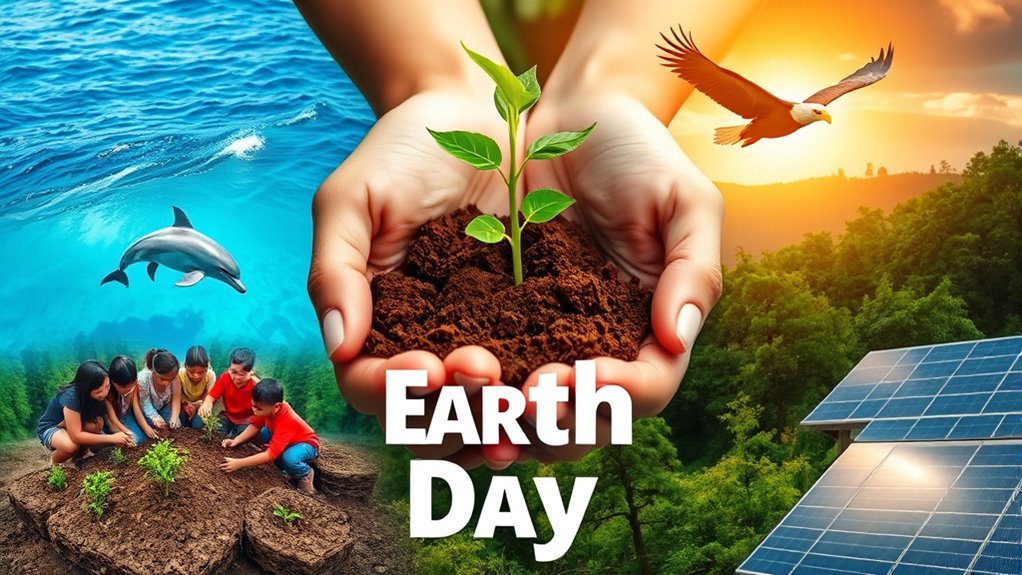This Earth Day, take action with these top conservation tips: use reusable bottles to cut plastic waste, eliminate single-use plastics, and join global cleanup efforts. Support recycling initiatives in your community while promoting carpooling and public transit. Encourage walking and biking for a healthier lifestyle and invest in renewable energy solutions. Get involved in local cleanups and participate in tree planting activities to enhance your environment. There’s so much more to explore for a sustainable future!
Key Takeaways
- Use reusable bottles to reduce plastic pollution and prevent thousands of single-use bottles from entering landfills each year.
- Participate in local cleanup events to foster community spirit and combat plastic pollution effectively.
- Support community recycling initiatives by engaging local businesses and providing convenient drop-off points for recyclables.
- Promote sustainable transportation options like carpooling and public transit to reduce carbon emissions and save on fuel costs.
- Invest in tree planting to enhance biodiversity, improve air quality, and combat climate change effectively.
Reduce Plastic Pollution Through Reusable Bottles

Each year, billions of single-use plastic bottles end up in landfills and oceans, contributing to a growing environmental crisis.
By switching to reusable bottles, you can make a significant impact. One reusable bottle can prevent hundreds of single-use bottles from being discarded each year, reducing plastic waste that harms our oceans and waterways. In fact, a 10-percentage point increase in refillable bottles could eliminate over 1 trillion single-use plastic bottles by 2030 and decrease marine plastic pollution by up to 22%. Additionally, choosing to reduce plastic waste aligns with the global movement towards sustainable travel options that emphasizes eco-friendly practices. Using reusable bottles not only helps the environment but also promotes high-quality hydration through better access to clean drinking water.
Switching to reusable bottles can prevent hundreds of single-use plastics from harming our oceans each year.
Plus, using tap water with reusable bottles saves you money over time. Your choice matters. By adopting reusable bottles, you help combat plastic pollution and protect marine life, all while enjoying a more cost-effective and sustainable hydration solution.
End Single-Use Plastics for a Cleaner Environment
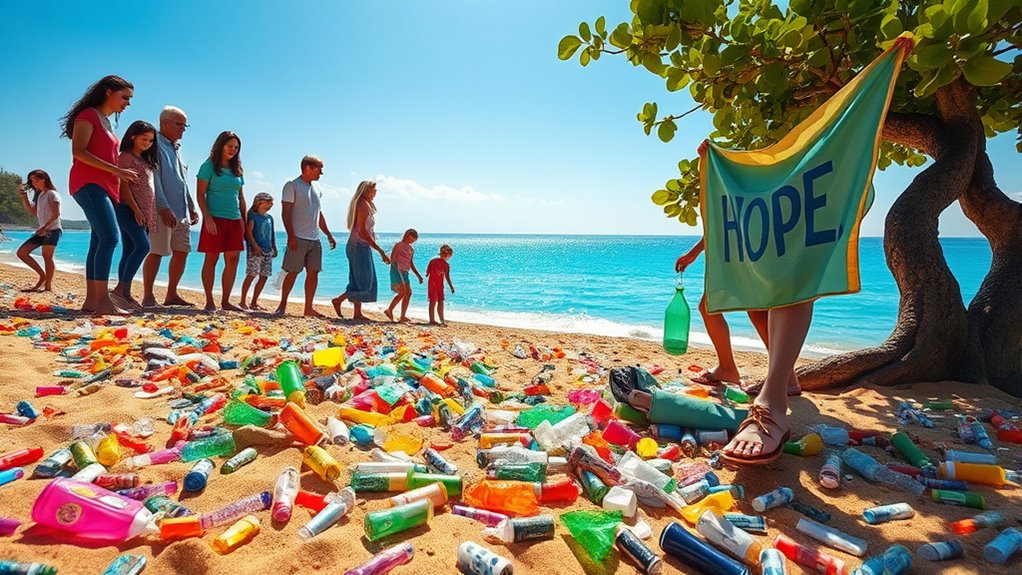
Ending single-use plastics is essential for creating a cleaner environment and protecting our ecosystems. These plastics harm wildlife by causing entanglement and ingestion, while their breakdown into microplastics contaminates our waterways and soil.
Shockingly, only 9% of plastic is recycled in Canada, with most ending up in landfills or as litter. The production and disposal of single-use plastics also contribute significantly to greenhouse gas emissions, exacerbating climate change. In fact, by 2050, single-use plastics are expected to account for 10% of global GHG emissions, which highlights the urgent need for action. Additionally, the life cycle analysis of hydrogen fuel cells suggests a lower environmental impact compared to traditional fossil fuels. The widespread use of dietary fiber in plant-based alternatives can also help reduce reliance on plastic packaging. Furthermore, transitioning to wood as a renewable resource can help mitigate climate change by minimizing reliance on fossil fuels.
Moreover, microplastics can infiltrate our food chain, posing health risks due to their toxic additives. By reducing single-use plastics, you can help mitigate these dangers and support sustainable alternatives like compostable products.
Every small change you make can lead to a cleaner, healthier planet for everyone.
Participate in Global Cleanup Efforts

Participating in global cleanup efforts is a powerful way to make a tangible impact on our environment. Events like World Cleanup Day have united millions—over 19 million in 2023—across beaches, rivers, parks, and more. Sustainable foraging practices can complement these efforts by promoting a healthier ecosystem. Engaging in these activities not only benefits the environment but also helps combat emotional damage associated with neglecting our natural surroundings.
By joining these initiatives, you contribute to a movement that transcends cultural boundaries and fosters community spirit. In 2024, volunteers removed over 78,000 pounds of waste from coastlines, showcasing the difference collective action can make.
Whether you’re cleaning your local park or joining an organized event, your efforts help raise awareness about pollution and inspire others. So, grab some gloves and rally your friends—get involved in a global cleanup and be part of the solution for a cleaner planet! Additionally, consider using portable camping toilets to minimize environmental impact while enjoying the outdoors.
Support Community Recycling Initiatives

Supporting community recycling initiatives is essential for creating a sustainable environment and fostering local pride. You can start by researching current recycling habits to tailor a program that fits your community’s needs.
Engage local businesses for funding and resources, and establish convenient drop-off points for recyclables. Promote education by organizing workshops that teach residents about recycling benefits and procedures. Creating an effective recycling program can also enhance elderly care by ensuring that seniors have accessible options to participate in sustainability efforts. Regular engagement with the community can lead to increased participation and a more successful recycling initiative.
Engage local businesses for support and set up easy drop-off points to enhance community recycling efforts.
Set clear goals to track progress, such as the volume of materials recycled or funds raised. By making recycling accessible and offering incentives, you can boost participation. These initiatives not only conserve resources and reduce waste but also create jobs, enhance community engagement, and foster a sense of pride in maintaining a clean, vibrant environment. Additionally, collective efforts can lead to improved mental health outcomes, reinforcing the importance of community involvement in recycling initiatives. To create a truly effective program, consider leveraging practical tips that help individuals and families organize their recycling efforts at home.
Promote Carpooling and Public Transit
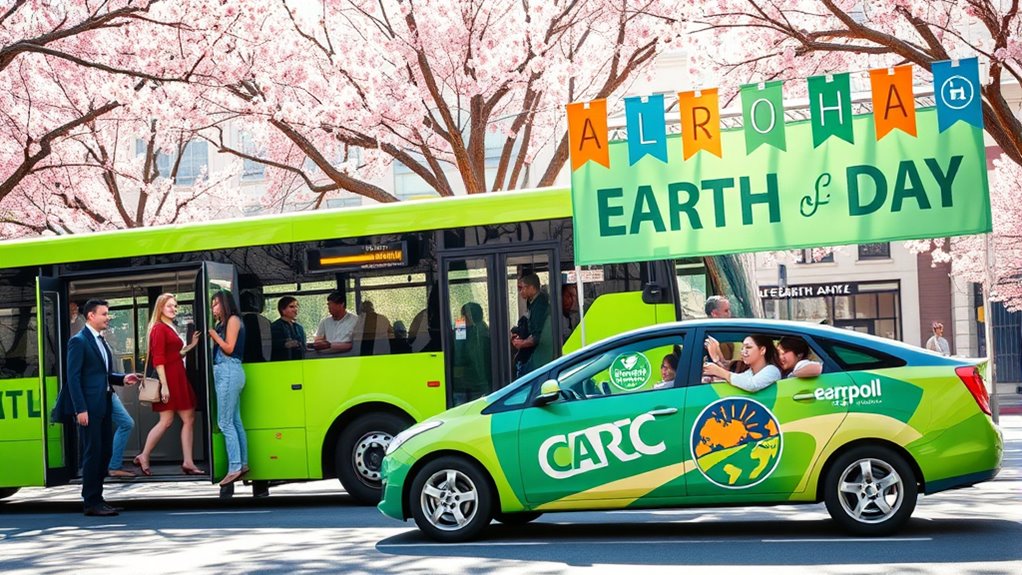
One of the most effective ways to reduce your carbon footprint and save money is by promoting carpooling and utilizing public transit.
Carpooling lowers carbon emissions by decreasing the number of vehicles on the road, saving you money on fuel costs while alleviating traffic congestion. This means better travel times and less hassle finding parking. Additionally, transport accounts for approximately 23% of global energy consumption, highlighting the significant impact of our transportation choices on climate change. Many banks have extended hours that can facilitate easier access for those using public transit for their banking needs. Moreover, sustainable brands often rely on efficient logistics to minimize their carbon footprint, further emphasizing the benefits of shared transportation methods. In Louisiana, alimony types can also play a role in financial stability post-divorce, just as shared transportation methods can enhance economic sustainability and environmental health.
On the other hand, public transit is a cost-effective option, often emitting less pollution per person than private vehicles, especially when powered by renewable energy.
Plus, it provides essential transport for those without cars, encourages physical activity, and reduces road congestion.
Switch to Electric and Hybrid Vehicles
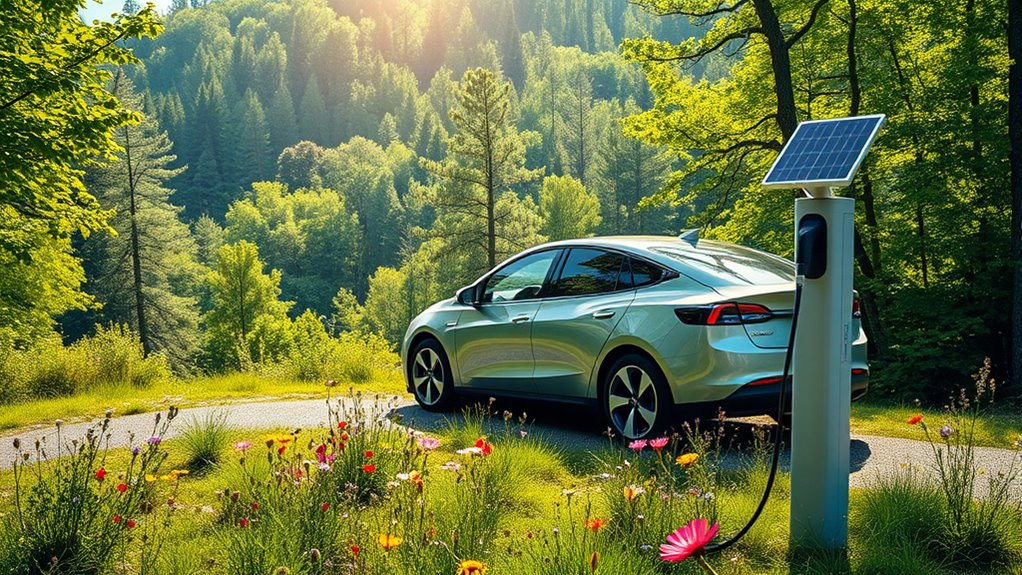
Switching to electric and hybrid vehicles can significantly reduce your carbon footprint while offering numerous economic and social benefits.
Electric vehicles (EVs) emit far fewer greenhouse gases than gasoline-powered cars, especially during operation. While battery production does generate emissions, the overall impact remains lower than that of gas vehicles. EV emissions can be significantly lower in regions with cleaner energy sources, highlighting the importance of local energy grids in maximizing the environmental benefits of EVs. Additionally, the shift towards renewable energy technologies like solar and wind can further enhance the sustainability of electric vehicles. Furthermore, co-working offices for productivity have been shown to foster innovative thinking about sustainable transport solutions in urban areas. The integration of intelligent tutoring systems in educational contexts has shown promising results in promoting sustainable practices among students and communities.
Electric vehicles produce significantly lower greenhouse gas emissions compared to gasoline cars, making them a cleaner choice for the environment.
Hybrids, on the other hand, consume less fuel and produce fewer emissions, making them an accessible option for many consumers. They also reduce noise pollution, which is a bonus for urban areas.
Plus, running these vehicles often leads to cost savings over time due to lower fuel consumption and maintenance needs.
Embracing EVs and hybrids can contribute to a cleaner environment and support job creation in the renewable energy sector.
Encourage Walking and Biking in Your Community

Encouraging walking and biking in your community not only promotes healthier lifestyles but also enhances the environment and local economy.
By choosing these active transportation options, you help reduce chronic diseases like obesity and diabetes while cutting healthcare costs. Additionally, creating accessible home environments for the elderly encourages them to participate in these activities more freely. Implementing energy efficiency evaluations in homes can further support sustainability efforts by promoting energy-saving practices. Cities that prioritize urban activities often see a boost in community engagement and participation.
Walking and biking significantly lower carbon footprints, contributing to cleaner air and a sustainable future. Additionally, choosing sustainable transportation options like public transit or carpooling can further reduce emissions and alleviate traffic congestion.
Investing in bike lanes and pedestrian pathways boosts local businesses by increasing foot traffic, creating jobs, and attracting tourism.
Moreover, these initiatives foster social cohesion and improve safety.
When you advocate for walkable and bikeable environments, you enhance your community’s quality of life, making it more inclusive and vibrant.
Invest in Renewable Energy Solutions

Investing in renewable energy solutions is crucial for building a sustainable future and combating climate change. By supporting solar and wind power, you’re contributing to a cleaner environment and a more resilient economy. In 2024, solar energy installations in the U.S. are set to exceed 219.8 GW, showcasing its rapid growth. With global investments surpassing $600 billion, the momentum is undeniable. Government initiatives like the Inflation Reduction Act are driving this shift, while private companies are increasingly adopting renewables for their sustainability goals. This significant increase in global renewable energy capacity reflects a growing commitment to clean energy solutions. Additionally, as countries like Kenya advance their crypto regulation framework, they may also explore renewable energy investments to support their digital economies. The integration of solar charge controllers in solar energy systems is also enhancing efficiency and reliability, making renewable energy solutions even more appealing. Furthermore, utilizing battery-less inverters can streamline energy usage by directly connecting solar panels to homes, allowing for immediate access to solar energy.
Engage in Local Cleanup Events
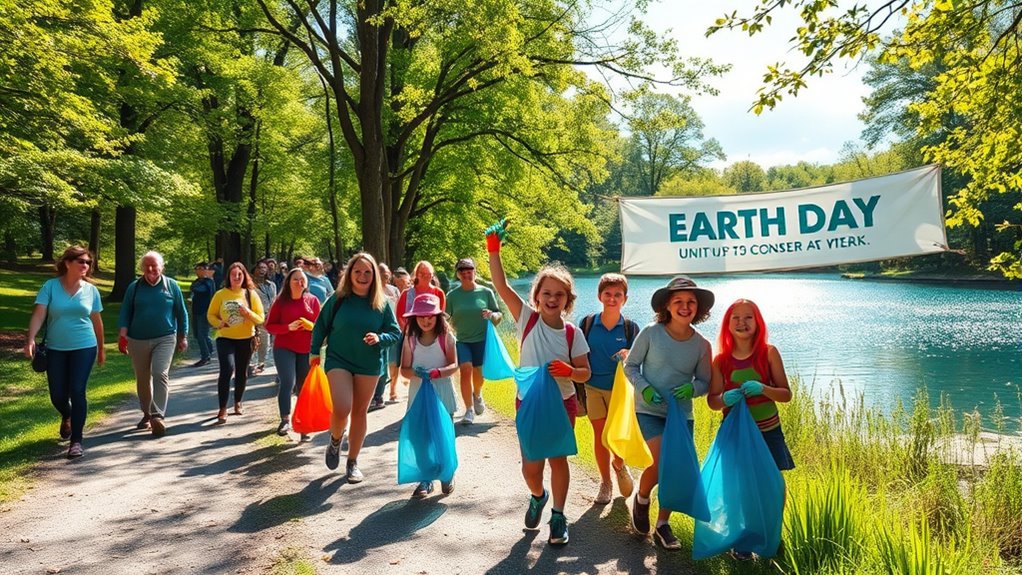
Participating in local cleanup events not only helps the environment but also fosters a sense of community and shared responsibility.
In 2023, organizations like the Surfrider Foundation engaged over 34,600 volunteers, removing more than 225,000 pounds of trash. You’ll be part of a larger movement, as these events focus on combating plastic pollution, collecting items like bottles and straws, which have become prevalent in our ecosystems. 190,654 pounds of trash collected during these cleanups highlights the ongoing need for community involvement.
By joining these efforts, you contribute to data collection that informs local and national policies aimed at addressing pollution. Plus, you’ll connect with like-minded individuals passionate about protecting our planet.
Participate in Tree Planting Activities

Tree planting activities can significantly impact the environment and your community. By joining these initiatives, you help absorb carbon dioxide, improving air quality and slowing climate change. Trees enhance biodiversity, provide habitats for wildlife, and stabilize soil, preventing erosion.
Moreover, tree planting isn’t just good for the planet; it benefits your health too. Green spaces boost mental well-being, lower asthma rates, and even reduce mortality rates from various causes. In fact, planting trees has been linked to a 20% reduction in non-accidental mortality rates, highlighting their importance for public health.
Participating in these activities fosters community engagement and strengthens social ties while beautifying your neighborhood.
Plus, strategically planted trees can save energy costs and increase property values.
Frequently Asked Questions
How Can I Encourage Others to Reduce Plastic Waste?
To encourage others to reduce plastic waste, start by sharing your own sustainable practices.
Use social media to showcase reusable products and alternatives to plastic.
Organize community clean-up events to raise awareness and engage others in hands-on activities.
Host workshops to educate people about the impact of plastic pollution and practical solutions.
Collaborate with local organizations to amplify your message, making it easier for everyone to join the movement for a cleaner environment.
What Are the Benefits of Using Public Transportation?
Using public transportation offers you numerous benefits.
It boosts the economy by creating jobs and increasing local sales. Environmentally, it reduces emissions and improves air quality, making your community healthier.
You’ll also enjoy increased mobility, connecting you to jobs and services while saving money—over $13,000 a year compared to owning a car.
Plus, public transit enhances your physical activity and safety, making it a smart choice for you and your community.
How Can I Find Local Tree Planting Events?
To find local tree planting events, start by checking environmental organizations’ websites, like the New York Restoration Project.
You can also explore local government sites and community groups for information.
Utilize online resources such as PlanetArk to search by postal code.
Don’t forget to follow local environmental groups on social media for updates.
Volunteering with parks and recreation departments is another great way to get involved and discover upcoming events!
What Are the Best Practices for Recycling in My Community?
Imagine your community as a thriving garden, where each recycled item is a seed planted for a sustainable future.
To cultivate this garden, start by conducting a waste audit to understand what you generate. Partner with local waste management for expert advice and equipment.
Engage your neighbors through workshops and social media, turning recycling into a community effort.
Finally, regularly assess and adjust your practices, ensuring your garden flourishes with every recyclable you save.
How Do Carbon Offsets Work in Renewable Energy Initiatives?
Carbon offsets in renewable energy initiatives work by funding projects that generate clean energy from sources like wind and solar.
When you purchase carbon offsets, you’re essentially investing in these projects, which help reduce greenhouse gas emissions. This investment supports a transition away from fossil fuels, while also creating jobs and benefiting local communities.
Conclusion
As Earth Day approaches, imagine standing amidst a vibrant forest, your hands deep in the earth, planting seeds for tomorrow. Picture the crisp air filled with laughter as you and your neighbors come together to clean up a local park. Every small action you take today can spark a wave of change, transforming our planet into a cleaner, greener haven. Will you be a part of this movement? The choice is yours, and the future awaits.
